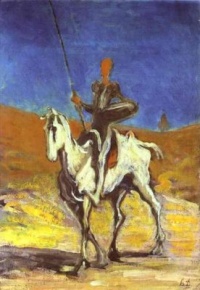Knight-errant
From The Art and Popular Culture Encyclopedia
|
"Many an argument did he have with the curate of his village as to which had been the better knight, Palmerin of England or Amadis of Gaul." --Don Quixote (1605) by Miguel de Cervantes “I’m a fairy tale princess in search of a knight and I never believed dreams come true. I’m just like you, I’m caught up in a one night love affair.”--"I'm Caught Up (In a One Night Love Affair)" (1979) by Inner Life |
|
Related e |
|
Featured: |
A knight-errant is a figure of medieval chivalric romance literature. The adjective errant (meaning "wandering, roving") indicates how the knight-errant would wander the land in search of adventures to prove his chivalric virtues, either in knightly duels (pas d'armes) or in some other pursuit of courtly love.
A Knight-errant is not a knight but a knight in waiting, a servant/messenger role in liege to a full knight or Prince. The template of the knight-errant are the heroes of the Round Table of the Arthurian cycle such as Gawain, Lancelot and Percival. The quest par excellance in pursuit of which these knights wander the lands is that of the Holy Grail, such as in Perceval, the Story of the Grail written by Chrétien de Troyes in the 1180s.
Although the character is part of the romance genre as it developed during the late 12th century, the term "knight-errant" itself is younger, for the first time recorded (as knygt erraunt) in the 14th-century poem Sir Gawain and the Green Knight.
Knight-errantry tales remain popular with courtly audiences throughout the Late Middle Ages. They are written in Middle French, in Middle English and in Middle German. In the 16th century, the genre becomes highly popular in the Iberian Peninsula, Amadis de Gaula was one of the most successful knight-errantry tales of this period. In Don Quixote (1605), Cervantes satirizes the Amadis romances and their popularity. Tales of knight-errantry then fall out of fashion for two centuries, until they re-emerge in the form of the historical novel in Romanticism.
See also


